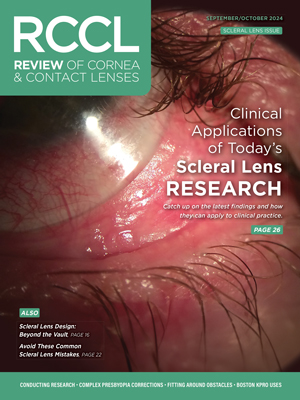 Contact lenses provide patients with peripheral vision that is unattainable with spectacles. And, visual acuity in those with high prescriptions is usually better with contact lenses vs. spectacles.
Contact lenses provide patients with peripheral vision that is unattainable with spectacles. And, visual acuity in those with high prescriptions is usually better with contact lenses vs. spectacles.
With contact lenses, wearers do not have to think twice about getting involved in physical activity; there’s no fear of damaging their glasses—and for those who lead active lifestyles, this is a huge functional benefit. But, what does this mean for our pediatric population.
Physical Characteristics of the Eye
The interpalpebral fissure is significantly smaller in the pediatric population, and it is a critical consideration when fitting children with contact lenses. Teaching children proper insertion and removal techniques can be particularly challenging. At times, a 13.8mm diameter lens (or smaller) may offer pediatric patients an advantage.
Issues that are caused by measurable differences in tear film function are typically not of much concern in our pediatric population. Most young patients have a robust tear film and high-quality meibomian gland secretions. Also, they are less likely to be taking medications that may alter the quality of the tear film. From an ocular surface health standpoint, this population may be best suited for contact lenses.
Determining Patient Responsibility
We have established that the physical characteristics of pediatric patients are conducive to contact lens success, but patient responsibility is just as—if not more—important. This is true with patients of any age, but it becomes critically important in the pediatric population. Practitioners may try to judge the level of the child’s responsibility during the exam, but it is also critical to discuss the child’s habits with the parent to determine whether the child is responsible enough to care for contact lenses.
But, be sensitive to the fact that some parents may not think that their child is responsible enough for contact lenses due to preconceived notions about their child being too young for contact lenses. In these instances, it is important to reassure the parent that contact lenses are safe in children by drawing from anecdotal experience and also from recent research. Understand that age, although important, should not be the only factor in our final decision. Research has shown that both children (ages eight to 12) and teenagers (ages 13 to 17) can safely wear contact lenses.1
Parents may think that because their children do not take good care of their glasses and are constantly needing them to be adjusted, they will not be able to care for their contact lenses. One possible reason that children are more likely to damage their glasses: Those who are active are the most likely to damage their glasses. These children may actually reap the most benefit from contact lens wear. Be sure to educate parents on the safety of contact lenses and clear up any misperceptions. As discussed earlier, offering information based on your previous fitting experiences coupled with current research on contact lens safety in pediatric patients will increase parents’ comfort level for contact lenses.
When to Consider Contact Lenses?
We should not lose sight of the fact that our pediatric population may benefit from contact lenses for many of the same reasons that adults do. Contact lens considerations aren’t significantly different for children than they are for teenagers and adults. We have a rich pipeline of materials and designs in both soft and RGP modalities that are well suited for most patients.
Contact lenses provide the optics directly on the eye, and thus, minimize much of the magnification and minification that spectacle lenses and high hyperopic and myopic correction may induce. In the same manner, contact lenses minimize the effects of aniseikonia secondary to significant anisometropia.
They are also a good option for those who lead active lifestyles. Additionally, many enjoy the option of contact lenses simply because they like the way they look without glasses.
Improve Self Perception
When fitting children with contact lenses, consider the self-esteem benefits that may result. Over a three-year period, evidence has shown a statistically significant improvement in self-perception regarding physical appearance, athletic competence and social acceptance in children wearing contact lenses vs. those wearing spectacles.2
According to Mitchell J. Prinstein, Ph.D., a clinical psychologist at the University of North Carolina, “Such a difference by simply being fit in contact lenses is significant.” Such changes in a child’s psychological development “set a new trajectory for their future development,” he says.3 Certainly, this should not be the sole reason to fit children in contact lenses, but it is incumbent upon the practitioner to consider quality-of-life benefits when discussing contact lenses with patients and parents.
Address Underlying Ocular Issues
Just as underlying ocular disease can compromise successful contact lens wear in teenagers and adults, it can also affect a child’s ability to wear lenses. An example of such a hindrance is blepharitis, which can undermine successful contact lens wear in children. Blepharitis responds well to eyelid hygiene regimens, such as lid scrubs. For cases that do not completely resolve with lid hygiene alone, an antibiotic such as azithromycin 1% used topically for two to four weeks will likely lead to resolution of signs and symptoms.
Another common condition that will undermine successful contact lens wear in children: allergic eye disease. These children should be treated accordingly, and depending on the resulting ocular signs and symptoms, clinical judgment should be used to determine whether contact lenses are in the child’s best interest.
Common prescription ocular treatments for allergic eye disease include Bepreve (bepotastine, ISTA Pharmaceuticals), Elestat (epinastine HCl, Allergan), Optivar (azelastine, Muro Pharmaceutical) and Patanol (olopatadine 0.1%, Alcon). These agents are all approved for b.i.d. dosing. Pataday (olopatadine 0.2%, Alcon) is the only treatment approved for q.d. dosing.
Weigh All the Factors
When considering a child’s candidacy for lens wear, first and foremost, make sure that patients have no underlying conditions. If they do, make sure to treat those conditions accordingly, and depending on the severity, you may need to reconsider lens wear.
Most children will, in fact, have a healthy anterior segment and be ideal for lens wear. Understand the child’s level of responsibility through discussions with the parent, and consider the effects of contact lens wear on a child’s self-perception. When all factors align, fitting this patient population is one of the most rewarding experiences a practitioner can have.
A Case in Point
“Megan,” a 6-year-old female, has expressed interest in contact lens wear to both her parents and myself, and her parents would like to know if she’s a good candidate for lens wear. She has worn glasses for the past two years.
Megan is relatively mature for her age and does extremely well in school. She plays competitive chess and is now starting to play basketball. Her best-corrected visual acuities are 20/25- O.D., 20/25- O.S., and 20/20-2 O.U. with the following prescription: +4.25 – 1.00 x 010 O.D., +6.50 – 0.75 x 010 O.S. Anterior and posterior segment examination were healthy O.U.
Megan was initially fit with a prism-ballasted hyperopic/astigmatic toric contact lens. She learned insertion and removal relatively quickly. At her first follow-up visit, she told me that she was much more comfortable playing basketball in her lenses. At this point, she wears a silicone hydrogel toric contact lens successfully.
Next month we will ask the question, “How Old is Too Old for Contact Lenses?” We would like to thank Dr. Mitch Prinstein for his insights.
1. Walline JJ, Jones LA, Rah MJ, et al. Contact Lenses in Pediatrics (CLIP) Study: chair time and ocular health. Optom Vis Sci. 2007 Sep;84(9):896-902.
2. Walline JJ, Jones LA, Sinnott L, et al. Randomized trial of the effect of contact lens wear on self-perception in children. Optom Vis Sci. 2009 Mar;86(3):222-32.
3. Personal communication. Mitchell J Prinstein. (November, 2009).


